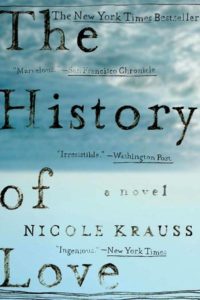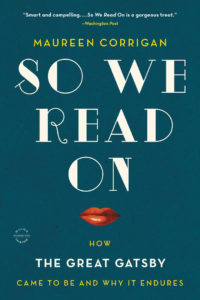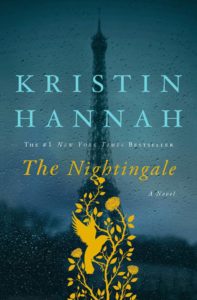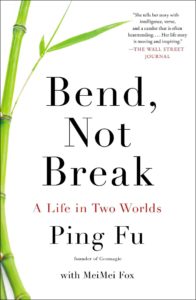Barbara’s Pick
December 2015
Under the Wide and Starry Sky
Nancy Horan
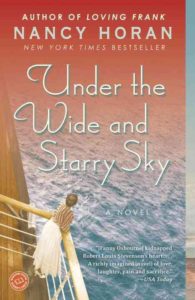 Whenever I’m looking for a new book to read, I’m attempting to access the formula History + Prose = Delight. In historical fiction I get the best of both worlds: I learn something (or more about something I knew a little about), and I savor a writer’s relationship with language.
Whenever I’m looking for a new book to read, I’m attempting to access the formula History + Prose = Delight. In historical fiction I get the best of both worlds: I learn something (or more about something I knew a little about), and I savor a writer’s relationship with language.
Under the Wide and Starry Sky tells the love story of British author Robert Louis Stevenson and his American wife, Fanny van de Grift Osbourne. She escaped a philandering husband in California by packing up her children and moving to Paris to study painting. Louis, as Stevenson was known, met her at an artist’s colony in France and was smitten. Fanny, older than he by ten years, took longer to return his admiration. Once united, however, they began an important literary partnership that lasted until his death. All of Stevenson’s major works were written after they married, and he considered her his most important sounding board.
Horan’s first book, Loving Frank, was a best-selling historical novel about Frank Lloyd Wright and his mistress Mamah Borthwick Cheney. Horan masterfully tells Louis and Fanny’s story—Louis’s near-debilitating respiratory illness and Fanny’s drawn-out divorce and other family tragedies.
I didn’t know much about Stevenson and knew nothing about his wife. They turned out to be compelling people worthy of being fictional characters. I thoroughly enjoyed this book and look forward to the next one!
Chris’s Pick
November 2015
The History of Love
Nicole Krauss
W.W. Norton and Company, Publishers, 2005
This wasn’t the book I planned to review. Jonathan Franzen’s latest book, Purity, has been at my bedside for a month, and I have finally finished slogging through it. As Franzen has been called one of America’s greatest writers, I had highly anticipated this publication. It is an interesting, very wordy, study of relationships, and parts of it are compelling. But the title of this section of our website is “Books We Love”. I did not love it. So. Instead I plucked out of my bookshelf a book I truly love and re-read it in four days.
The History of Love is an exquisite book. There are several voices that narrate this complex story, but the writing is so clever you have no problem distinguishing between them, and eventually knowing and empathizing with them.
We meet Leo Gursky first, an octogenarian Jew, who has come to New York from Poland having survived the Holocaust hiding in “trees, but also holes, cellars, and cracks”, after World War II. Leo is terrified that he has become invisible to the rest of the world, and makes a point each day to be seen—often by deliberately knocking over his coffee cup, or spilling the salt in a cafe. In Poland, he writes a novel, The History of Love, about Alma, the woman he loves. (Alma has been sent to America to escape the war, and eventually marries, thinking Leo dead. Yet Leo continues to love her until she dies, even sitting daily at her bedside in the hospital. “She was tiny and wrinkled and deaf as a doorknob. There was so much I should have said. And yet. I told her jokes.”)
Leo entrusts a friend with his precious manuscript, who later confesses it has been lost.
Alma Singer is a fourteen year old living in Brooklyn with her brother, Bird, and her mother, Charlotte, a translator. All three are separately dealing with the death of Alma’s father. Alma learns that she was named after the heroine in her father’s favorite book, The History of Love—an obscure book he finds in the window of a bookshop in Chile, written in Spanish. When a stranger commissions Charlotte to translate The History of Love into English, Alma becomes obsessed with finding the stranger, as well as finding the woman for whom she was named.
We follow the mysterious twists and turns of these two people’s lives, with the book (within a book), The History of Love, at its center. Each of Krauss’s characters is beautifully drawn. Leo stays with you long after the last page, and Alma, tenuously on the verge of adulthood, and Bird, who believes he is a lamed vovnik—a Messiah—are so endearing that you can’t help falling a little bit in love with them both.
By the end of the book, the two main characters come together, as they must, with a surprising catalyst.
Once again, Krauss’s stylistic writing becomes an important ingredient in the conclusion. And once again, I closed this book with a sigh.
Sonja’s Pick
October, 2015
My Beloved World
Sonia Sotomayor, Alfred A Knopf, Publisher, 2013
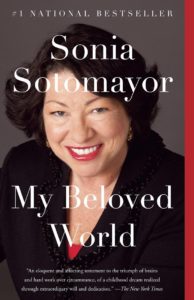 There’s work to be done so get on with it!
There’s work to be done so get on with it!
This is the memoir of an amazingly confident woman. It is especially positive for those of us that believe in the American “way” and a woman’s chance to succeed. She prefaces it is a heartfelt memoir and it is the story of a woman whose rise to the top of her profession was possible through hard work, diligence and purpose.
Her beginnings in the Bronx were meager. An alcoholic father and a mother who was even afraid to administer the life saving insulin shots she needed. At the age of 8, she was diagnosed with juvenile diabetes and since then determined she would have to take care of herself if she was going to succeed.
She excelled and was valedictorian of her high school class but had a great deal of “catching up” to do when she entered Princeton with a full scholarship. She joined a Puerto Rican student group which involved her with affirmative action. That began her involvement with helping others who were less fortunate. Her deprived upbringing provided her with the empathy that framed her thoughts later.
After graduating Princeton with the highest honors, she went on to Yale Law School. She worked in the NY District Attorneys office and in private practice before being appointed to the bench. Above all she values integrity, fairness and avoidance of cruelty.
A good read. A happy ending.
Karen’s Pick
September 2015
Go Set a Watchman
Harper Lee, Harper Collins July 14, 2015, 278 pages
It was hard to contain my excitement after hearing that Harper Lee’s new novel, Go Set A Watchman, would be released on July 14, 2015. Touted as a sequel, to the classic, To Kill a Mockingbird, I could only imagine the people Scout and Jem had become or what injustices our beloved Atticus had righted, or how the small fictional town of Maycomb (Alabama) was now a community of citizens who respected, or at the very least, tolerated one another. Unfortunately, the reader soon realizes this is not the case and that Go Set A Watchman is not a new story but rather a first draft for Lee’s only “real” novel To Kill a Mockingbird.
Immediately, the reader is reminded of how alive Lee’s writing can be. The first few chapters of the book are beautifully written. Alan Gopnik, critic for The New Yorker magazine wrote that Lee’s writing is at times magical:
“There is a little set piece about the arrival of a train at a flag stop that makes one feel nostalgic for one’s Southern childhood even if one never had a Southern childhood.”
No matter how well crafted the writing, all too quickly the plot becomes awkward and choppy, leaving the reader unsure of Lee’s intent.
Scout, now a 26-year-old and referred to as Jean Louise travels home for her yearly visit to see the now ailing Atticus. For those who have read TKM, several new Maycomb citizens are introduced in GSW. Atticus’s brother Dr. (Jack) Finch, is a commanding and highly likeable personality and Jean Louise’s confidant, and Henry Clinton, is the long-time suitor of Jean Louise and Atticus’ protégé. Missing from GSW is Boo Radley, and brother Jem, who has much less of a presence.
Much has been said about Scout’s traumatic discovery that Atticus is a member of the Citizens Council, a racist and almost Klan-like group of Maycomb’s finest. Jean Louise knows her father to be the most honorable man imaginable, whose integrity, humor, and patience makes him larger than life. This the time when the reader must step outside the book to remember the disconnect we have with our own “reality ” at the age of six, and our coming –of-age vision of the same truth which is sometimes harsh. It is when Jean Louise confronts Atticus with being a racist the reader gets to hear the clear and disturbing voice of race relations in the South the 1950’s. When confronted by Scout about his views on race Atticus explains to Scout,
Have you ever considered that you can’t have a set of backward people living among people advanced in one kind of civilization and have a social Arcadia?
Fortunately the beautiful style of writing that is so distinct in TKM is apparent in many powerful passages. When a desperate and confused Jean Louise runs to Calpurnia, the now retired cook to the Finch family, to better understand the extent of the racial discord in Maycomb she asks,
“Cal, Cal, Cal, what are you doing to me? What’s the matter? I’m your baby, have you forgotten me? Why are you shutting me out? What are you doing to me?”
Calpurnia lifted her hands and brought them down softly on the arms of the rocker. Her face was a million tiny wrinkles, and her eyes were dim behind thick lenses.
“What are you all doing to us?” she said.
If the publisher had been upfront with the readers and presented Go Set a Watchman as the draft it is, it would have been a great discussion tool for students of writing and literature. Lee’s Go Set a Watchman will never be a classic, however, the writing is often as powerful, and stylistic as Lee’s “other” book. With a little imagination and interest on the part of the reader, it is clear how Go Set A Watchman evolved into one of the most enduring novels of the 20th century.
Bill’s Pick(s)
August, 2015
The Great Gatsby
F Scott Fitzgerald
and
So We Read On: How the Great Gatsby Came to Be and Why It Endures
Maureen Corrigan
Like a good doubleheader from baseball seasons past, this is a doubleheader for the summer reading season. The first book is an American classic that usually shows up on secondary school reading lists. The second book, a work of non-fiction, discusses the settings, facts, and author of that book.
The classic is F. Scott Fitzgerald’s The Great Gatsby (Charles Scribner’s Sons, 1925). Most of us probably read the novel long ago or saw one of the movie versions that tried to capture the essence of Gatsby and his crowd. But, Fitzgerald’s book from 1925 deserves another (or, for those who missed it, a first) read. It is filled with beautiful, evocative language, a memorable cast of Jazz Age characters, and issues and ideas that still resonate. The book lends itself, almost 100 years after its publication, to relevant discussion about the illusion of the American Dream, the effects of class, and the influence of money.
Nick Carraway, the honest Midwestern narrator, tells us what he knows about the Gold Coast of Long Island and its inhabitants: Daisy, lovely but superficial; Tom, her wealthy, racist, bullying husband; Jordan, their golfer friend who cheats and lies; and Gatsby. Nick travels by train to New York City, attends Gatsby’s glittering and wild parties, meets Tom’s mistress in her overstuffed New York apartment, and, with Gatsby, meets a gangster who sports cufflinks fashioned out of human teeth. He hears the rumors and sees the carelessness of their lives.
Through it all, Jay Gatsby remains the ultimate optimist. Despite his shady background and connection to bootleggers, it is easy to like Gatsby, to root for him, and even to hope his dream is not an illusion.
In So We Read On: How the Great Gatsby Came to Be and Why It Endures (Little, Brown and Company, 2014), Maureen Corrigan, an NPR book critic, admits that when she read the novel in high school she did not like it at all. Now, however, she explains it is a work that she loves. Her enthusiasm is obvious.
Corrigan travels Fitzgerald’s path to the shores of Long Island, visiting the novel’s settings as well as places the author lived or visited. She researched Fitzgerald’s papers at Princeton and even endured a Gatsby boat tour. Corrigan elucidates wonderful facts and shares clever opinions about the author and his novel. Her personal experiences and observations make this book – part history, part literary criticism and part memoir – come alive. Corrigan’s ultimate message: Read Gatsby again. And, maybe, even again.
Barbara’s Pick
July, 2015
Travels with Charley
John Steinbeck
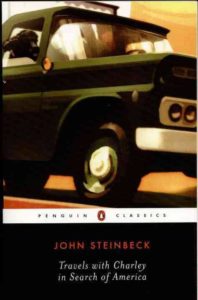 Another dog-related review from me! Do you sense a theme? (Really, I do read other kinds of books.)
Another dog-related review from me! Do you sense a theme? (Really, I do read other kinds of books.)
For many of us, The Grapes of Wrath was required reading in school, but John Steinbeck wrote many more stories, books, plays, and magazine articles. In the last years of his life, he felt he’d lost touch with the America he had written about for so long, so he devised a route to take him across most of the United States—and he chose as his traveling companion his 10-year-old French poodle, Charley. Steinbeck knew Charley would help him talk to the strangers he would encounter in his months on the road and referred to him as his “mind-reading dog.” After outfitting a truck with a special camper and loading it with any and everything he might need or want, off the two adventurers went.
Steinbeck’s lean, elegant writing is a pleasure to read, but this is not a buddy story with happiness everywhere. Steinbeck bemoans the progression of industry, the encroachment of pollution in the cities, and the overdevelopment of wilderness. It’s considered a period piece for good reason, as several anecdotes reference the spread of mobile home parks and the issue of segregation.
All in all, if you are nostalgic for the early 1960s and you like a good yarn, this book is a relatively quick read and will have you laughing out loud in spots. Happy summer reading!
Nouhad’s Pick
June 2015
One Thousand White Women: The Journals of May Dodd (historical fiction)
Jim Fergus, Publisher: St Martin’s Press, 1998
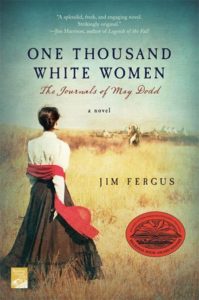 March 23, 1875, begins May Dodd’s journey west to the unknown. Her only hope of freedom from an insane asylum was to participate in a secret federal government program and be a bride to a Cheyenne Indian warrior. This was a proposed by “Sweet Medicine Chief” Little Wolf to help save his people. In his address to President Grant, he stated: “It is the Cheyenne way that all children who enter this world belong to their mother’s tribe . . . [in this way they will learn the white man’s way, so] from this day forward the blood of our people shell be joined.” This was the request for One Thousand White Women to be gifted to the Cheyenne as brides for their warriors. The U.S. government received one thousand horses in return.
March 23, 1875, begins May Dodd’s journey west to the unknown. Her only hope of freedom from an insane asylum was to participate in a secret federal government program and be a bride to a Cheyenne Indian warrior. This was a proposed by “Sweet Medicine Chief” Little Wolf to help save his people. In his address to President Grant, he stated: “It is the Cheyenne way that all children who enter this world belong to their mother’s tribe . . . [in this way they will learn the white man’s way, so] from this day forward the blood of our people shell be joined.” This was the request for One Thousand White Women to be gifted to the Cheyenne as brides for their warriors. The U.S. government received one thousand horses in return.
May Dodd chronicles how the group of women coped to learn Cheyenne ways, learned the daily routines and experienced the adventures and hardships, fell in love, gained respect, experienced joy, and found loyalties. May’s journal is the breathtaking adventure of romance, triumph, and sorrow.
The author’s description of life out west is so vivid that one’s imagination brings it alive. This story is a capsule in time for America, full of adventure, emotions, and suspense, and makes one anxious to turn the page.
Yes, Please
Amy Poehler, Published by Harper Collins, October 28, 2014
A brief digression: one reason why I love our library… When I discover a book I want to read, I log onto the library website and request a copy. Sometimes there are long electronic queues for a popular book (sometimes not), but I rarely feel the need to be the first to read anything; I just want to read it. Then, I forget about it. But one day, in the middle of a stressed workweek, I will receive an email that says the book is waiting for me! It is a tiny, happy, unanticipated “Christmas morning of pleasure” to get that email. (Fellow readers, if you have not made use of this service, try it! You’ll like it!)
And that is why I am reviewing Yes, Please, because it unexpectedly came my way this month, and I have enjoyed it.
Amy Poehler’s memoir is a candid, amusing, but often poignant collection of essays that appear to follow no form or timeline, but is divided into three sections: Say Whatever You Like, Do Whatever You Want, and Be Whoever You Are, all prefaced by instructions Poehler has written as to how to use the book.
Poehler discusses, among other things, motherhood, sex, school, insomnia, her “too safe” childhood, popularity, Haiti, and her comedic career up through the present. Her chapters have photos scotch-taped onto the pages with each section defined by wild colors and exclamation points, indicative of her personality. Her section on divorce should ring true to anyone who has been through it, and even to those who have not. Many of the chapters are “words of wisdom,” though she clearly expects you to take it or leave it. None of what she espouses seems new, necessarily, but all of it is relatable. I think, particularly as women, yes, we nod, yes, that’s true. Read “I’m So Proud of You”…yes, yes, yes.
Towards the end of the book, Poehler spends a good deal of time talking about her Parks and Recreation show and cast members, and it is fun to go backstage to see what these folks are like.
I liked this woman after reading her book. She can be self-effacing, but never humble, which seems correct to me. I often laughed while reading it, which is a very enjoyable way to experience a book.
I liked the end, which to me is important. You have to know how to end a book. She does.
Nancy’s Pick
April 2015
The Invention of Wings
Sue Monk Kidd
January 2014 by Penguin Publishing Group
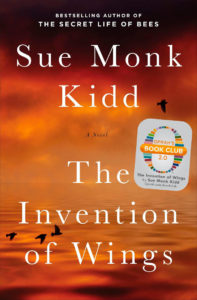 The Invention of Wings is a fictionalized history of the real South Carolina Grimkes sisters, Sarah and Angelina. As adults, they both work in the abolitionist and women’s rights movement.
The Invention of Wings is a fictionalized history of the real South Carolina Grimkes sisters, Sarah and Angelina. As adults, they both work in the abolitionist and women’s rights movement.
The narrative includes a young slave, Hetty, who is given to Sarah as her eleventh birthday present. Sarah even at that young age despises slavery. Sarah fails in her attempts to allow Hetty her freedom.
Sarah teaches Hetty to read, a criminal offense in antebellum South Carolina. As punishment, Sarah is banned from using her father’s library. Sarah’s hope of studying law is not allowed. She is ridiculed by her father and brothers for even thinking of such an idea.
Hetty is whipped for the offense of learning to read. Hetty’s story involves much physical pain and emotion emptiness. She learned to sew and quilt from her slave mother. Together they make a quilt that tells her family’s life story. As Hetty ages, her seamstress skills allow her a way to escape from the horrors of slave life.
Much of the book is historically based. The author’s research of facts, dates, letters, and articles provide a believable story of Sarah’s life in the days of slavery and Hetty’s life as a slave. Sue Monk Kidd uses the factual details to write a truly inspired fictionalized story of Hetty’s life of slave girl to women.
The Invention of Wings does engage the reader to explore and experience the difficult and complex ideas of slavery. Readers experience the horror of slavery, the lack of woman’s rights, and the strength of the spirit to survive.
Karen’s Pick
March 2015
The Nightingale by Kristin Hannah
Publication Date: February 3, 2015 – St. Martin’s Press
The Nightingale is the story of two sisters, WWII, tragedy, horror, passion and the human condition, It’s 1939, in the French village of Carriveau, and Vianne Mauriac is preparing for her husband to leave her to fight the Germans on the Front. Soon after his departure, the Nazis occupy this quiet countryside and a young German captain moves into the Mauriac home. This forces Vianne and her young daughter Sophie to co-exist with the enemy. As the war escalates, food and money become scarce, and hope dwindles, Vianne’s once joy-filled world becomes bleaker and bleaker. Abruptly, she is forced to make unthinkable moral and ethical decisions that force the reader to ask the question –what would I do in this situation?
Concurrently, Vianne’s sister Isabelle, a burdened and dejected 18-year-old, leaves the Mauriac family home and travels to Paris. She has been searching for a purpose in her young life and when given the opportunity to join the French Resistance, she does so eagerly. She needs to make a difference. As a purpose driven member of the group, Isabelle chooses a life path and makes decisions that push her physically and emotionally beyond comprehension. Isabelle is now forced to define herself and those who once confused her. (The author has stated that her inspiration for Isabelle was the real life story of a woman who led downed Allied soldiers on foot over the Pyrenees.
The sisters’ seemingly different circumstances are skillfully woven together by the author. Hannah’s writing often took me to places that were too hard to imagine yet I could not put the book down. While tragic, this compelling novel celebrates the resilience of spirit and the strength of will. This is made crystal clear in the opening words of the book:
In love we find out who we want to be. In war we find out who we are.
If you are ready to take a seat on an emotional rollercoaster ride, I very highly recommend The Nightingale.
Barbara’s Book Pick
February 2015
New Life, No Instructions: A Memoir
Gail Caldwell, Random House
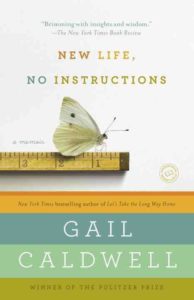 As a complete “dog person” I was immediately grabbed when the description of this memoir mentioned a Samoyed puppy, but it is so much more. The author, former Boston Globe book critic Gail Caldwell, found her worldview changed as she approached 60 when after getting a new puppy she realized she needed a hip replacement. Not only was her hip repaired, but her polio-damaged right leg gained five-eighths of an inch—so the limp she had had for her entire life was now nearly invisible.
As a complete “dog person” I was immediately grabbed when the description of this memoir mentioned a Samoyed puppy, but it is so much more. The author, former Boston Globe book critic Gail Caldwell, found her worldview changed as she approached 60 when after getting a new puppy she realized she needed a hip replacement. Not only was her hip repaired, but her polio-damaged right leg gained five-eighths of an inch—so the limp she had had for her entire life was now nearly invisible.
Caldwell writes beautifully about her childhood in Texas and her relationships with her parents, as well as navigating the world of middle age alone and losing loved ones (human and canine). She also explores how her life changed after losing the limp that had tried to define her since childhood and offers a cautionary tale about ignoring joint pain for years on end.
As a middle-aged woman myself, it was fascinating to observe a peer go through what has now become a fairly routine medical procedure and emerge relatively unscathed on the other side. She doesn’t sugar coat rehab, but she does show how to elegantly endure it.
I highly recommend this book, a quick read, and look forward myself to reading more from this author.
Sonya’s Pick
January 2015
Bend, Not Break: A Life in Two Worlds
Ping Fu, December 2012
Narrates the Life of Ping Fu starting with childhood in China at the Dawn of the Cultural Revolution and continues through her role as co founder and CEO of Geomagic, a 3D graphic software development company in the US.
I love reading about history as told through the eyes of a person or their family. This is such a story. Ping was torn away from her merchant class parents who were “re-educated” and forced to raise her 4 year old sister alone in what appeared to be a dormitory commune. Knowing that she will survive helps you through the brutality of her upbringing. She not only managed to attend a Chinese University, but also to eventually make it to the US where she studied computer science and among other accomplishments helped invent the first Web browser.
The title of the book comes from a saying of the author’s father about bamboo and its ability to move with the harsh wind instead of snapping under pressure. That helped Ping survive.
After reading the book, I came upon some reviews with large discrepancies, some citing her being a liar especially about her time in China. She denies those claims. Still, it is a gripping and transformative story of survival in a time I knew nothing about.
